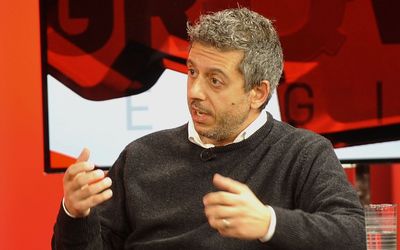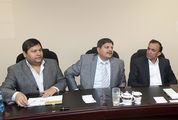THE irony of one of the world’s oldest and most primal industries — getting hard stuff out of the ground — being aided by the latest, cutting-edge and largely intangible technology, 3D "immersion" training, is not lost on Andreas Cambitsis, director and co-founder of Cyest Corporation.
"Cyest is a hybrid that provides professional business and strategic services, but also uses and develops technologies. We provide analytical technology services across various industries but with a strong focus in mining," he says.
Started in 2000, Cyest was self-funded from the start.
"Our premise was always that if we had a good idea, let’s find forward-thinking clients to help co-fund it. If the client buys into the idea, then we will deliver on something we know is useful," says Cambitsis.
A mining company that first agreed Cyest had a good idea was Anglo American Platinum (Amplats), an "anchor client" since 2003.
"Amplats has worked in collaboration with Cyest for more than 10 years in a variety of domains," confirms Clive Govender, the company’s head of supply chain.
"However, it is the developments in virtual reality and 3D visualisation over the past two years that are especially exciting from an innovation perspective. Technologies most frequently seen in the gaming environment are now being used in the mining world to assist with training and post-event analysis."
Cambitsis says he learnt to programme at 10, but also loved building things, and so studied aerospace engineering in the UK before completing a Master’s in operations research, "which is using computers to solve business problems". His first job was with US strategic consulting firm Monitor, in SA, which did a lot of mining work.
"This gave me and the team — who would later start Cyest — a really good understanding of the ‘big picture’; of what drives shareholder value, and decision-making at an executive level. We had a strong foundation in the mining sector and so when we started Cyest, a lot of them came calling."
...
TWO things, broadly, led to the creation of Cyest. "There are two types of strategic engagement," says Cambitsis. "The qualitative type, which can be rather abstract and intangible; and the more quantitative, which uses numbers and facts, and their analysis, as strategy drivers.
"So we asked: ‘Can’t we use and deliver technology to the client as a type of consultant; can’t we engage clients using technology as a sustainable way of empowering them?’ This was our ethos from the outset; taking high-end, strategic consultancy thinking and using technology as a way of delivering it."
It’s not just about gathering data, it’s about making it work.
"The amount of data in the world doubles every 18 months and that window is getting shorter," says Cambitsis. "But if you look at the economic benefit gained from this data, it’s dismal; the ratio is very poor.
"And technologies contribute, in part, to the problem in the sense that they still play a big role in helping generate data — but offer little or no help in how it can be utilised. This data needs to be used and made useful; it needs to be applied to specific industry environments and their decision-making.
"Data needs a business understanding and, most especially, context. This is really key: data needs to be made usable and relevant so people can take action against it that will drive economic benefit."
...
AS WELL as offering technology-based services, such as mine scenario planning, life-of-mine economics and performance diagnostics, Cyest does work on the operational side to validate mining plans, maximise the capabilities and capacities of mining assets, and help ensure they are delivering to target and operating optimally.
These are expected and somewhat obvious but when Cambitsis notes things "snowballed with the Oculus Rift" play, his eyes light up as he disappears to fetch what turns out to be compact virtual reality goggles.
"Advanced 3D visualisation and virtual reality immersion have come back with a vengeance," he says. "We have built a simulation programme that Amplats uses at its Centre of Experiential Learning, to train management on an experiential basis.
"The simulation helps with systemic thinking and how to make decisions with an understanding of how they impact the whole value chain."
Govender confirms these advances are helping Amplats remain competitive and drive the modernisation strategy central to their business.
Similar technology is being used elsewhere — Cambitsis gives Australia’s mining industry as "the benchmark" — but Govender notes, "as a global leader in platinum group metals, from resource to market, Amplats remains at the forefront of many technologies.
"Globalisation has ensured that markets are diverse and mining companies and service providers both keep pace with global standards," Govender says.
Key in achieving global standards in mining is ensuring safety.
"While the current use of the 3D virtual reality simulation technology is very much in the context of training, the emphasis is now to take that to be used in the context of safety, so that people can get trained and be more alert in assessing their environments through wearing these headsets and utilising this technology during simulation training," says Cambitsis.
On his tablet screen, Cambitsis boots up a 3D simulated image of one of the deepest open-pit mines in the US (also a client), which recently had a "massive landslide".
This is visible as a smooth swathe of earth that contrasts immediately with the terraced, unaffected earth on the either side of it.
As we move forward and suddenly tip down, even though sitting at a desk in an office in Sandton, the sense of size and sudden movement is stomach churning.
Black dots soon emerge as enormous trucks, giving scale too.
"We can use this simulation to see how to reconfigure the pits," says Cambitsis matter-of-factly, the vertigo no longer affecting him.
"We understand this technology really well, it’s a differentiator for us.
"We’re good at applying it to business problems — we need to understand and remember that this isn’t just about a ‘cool factor’; all of this technology needs to feed back into the business."
Cyest has found a willing and able partner in this regard with Amplats, a company Cambitsis says has become "far more dynamic" under CEO Mark Cutifani’s watch.
"He is driving a culture of innovation and change, one that is more amenable to pursuing an open innovation model — that is, where a company recognises it doesn’t have the strengths or capabilities to innovate as fast as it would like, but is happy to work with partners who can help with this," he says.
...
GOVENDER echoes this sentiment: "Collaboration with technology partners, such as Cyest, has allowed Amplats to review our business, carefully interrogating options and allowing us to drive discontinuous change, as opposed to gradual incremental progress.
"The mining technology space is fairly competitive and it is therefore essential to benchmark globally, not only with other mining companies, but also across sectors."
Given that the virtual reality training went live only about two months ago, it remains to be seen how it will trickle down to positively affect business processes, but that is, as it always will be, the aim: this is not technology for technology’s sake.
"Under times of huge economic pressure, as now, technology has to be part of longer term plans with regard to creating a sustainable mining environment," says Cambitsis.

Andreas Cambitsis of Cyest, a company that provides the latest 3D visualisation and virtual reality technical support to especially the mining industry. Picture: FREDDY MAVUNDA
THE irony of one of the world’s oldest and most primal industries — getting hard stuff out of the ground — being aided by the latest, cutting-edge and largely intangible technology, 3D "immersion" training, is not lost on Andreas Cambitsis, director and co-founder of Cyest Corporation.
"Cyest is a hybrid that provides professional business and strategic services, but also uses and develops technologies. We provide analytical technology services across various industries but with a strong focus in mining," he says.
Started in 2000, Cyest was self-funded from the start.
"Our premise was always that if we had a good idea, let’s find forward-thinking clients to help co-fund it. If the client buys into the idea, then we will deliver on something we know is useful," says Cambitsis.
A mining company that first agreed Cyest had a good idea was Anglo American Platinum (Amplats), an "anchor client" since 2003.
"Amplats has worked in collaboration with Cyest for more than 10 years in a variety of domains," confirms Clive Govender, the company’s head of supply chain.
"However, it is the developments in virtual reality and 3D visualisation over the past two years that are especially exciting from an innovation perspective. Technologies most frequently seen in the gaming environment are now being used in the mining world to assist with training and post-event analysis."
Cambitsis says he learnt to programme at 10, but also loved building things, and so studied aerospace engineering in the UK before completing a Master’s in operations research, "which is using computers to solve business problems". His first job was with US strategic consulting firm Monitor, in SA, which did a lot of mining work.
"This gave me and the team — who would later start Cyest — a really good understanding of the ‘big picture’; of what drives shareholder value, and decision-making at an executive level. We had a strong foundation in the mining sector and so when we started Cyest, a lot of them came calling."
...
TWO things, broadly, led to the creation of Cyest. "There are two types of strategic engagement," says Cambitsis. "The qualitative type, which can be rather abstract and intangible; and the more quantitative, which uses numbers and facts, and their analysis, as strategy drivers.
"So we asked: ‘Can’t we use and deliver technology to the client as a type of consultant; can’t we engage clients using technology as a sustainable way of empowering them?’ This was our ethos from the outset; taking high-end, strategic consultancy thinking and using technology as a way of delivering it."
It’s not just about gathering data, it’s about making it work.
"The amount of data in the world doubles every 18 months and that window is getting shorter," says Cambitsis. "But if you look at the economic benefit gained from this data, it’s dismal; the ratio is very poor.
"And technologies contribute, in part, to the problem in the sense that they still play a big role in helping generate data — but offer little or no help in how it can be utilised. This data needs to be used and made useful; it needs to be applied to specific industry environments and their decision-making.
"Data needs a business understanding and, most especially, context. This is really key: data needs to be made usable and relevant so people can take action against it that will drive economic benefit."
...
AS WELL as offering technology-based services, such as mine scenario planning, life-of-mine economics and performance diagnostics, Cyest does work on the operational side to validate mining plans, maximise the capabilities and capacities of mining assets, and help ensure they are delivering to target and operating optimally.
These are expected and somewhat obvious but when Cambitsis notes things "snowballed with the Oculus Rift" play, his eyes light up as he disappears to fetch what turns out to be compact virtual reality goggles.
"Advanced 3D visualisation and virtual reality immersion have come back with a vengeance," he says. "We have built a simulation programme that Amplats uses at its Centre of Experiential Learning, to train management on an experiential basis.
"The simulation helps with systemic thinking and how to make decisions with an understanding of how they impact the whole value chain."
Govender confirms these advances are helping Amplats remain competitive and drive the modernisation strategy central to their business.
Similar technology is being used elsewhere — Cambitsis gives Australia’s mining industry as "the benchmark" — but Govender notes, "as a global leader in platinum group metals, from resource to market, Amplats remains at the forefront of many technologies.
"Globalisation has ensured that markets are diverse and mining companies and service providers both keep pace with global standards," Govender says.
Key in achieving global standards in mining is ensuring safety.
"While the current use of the 3D virtual reality simulation technology is very much in the context of training, the emphasis is now to take that to be used in the context of safety, so that people can get trained and be more alert in assessing their environments through wearing these headsets and utilising this technology during simulation training," says Cambitsis.
On his tablet screen, Cambitsis boots up a 3D simulated image of one of the deepest open-pit mines in the US (also a client), which recently had a "massive landslide".
This is visible as a smooth swathe of earth that contrasts immediately with the terraced, unaffected earth on the either side of it.
As we move forward and suddenly tip down, even though sitting at a desk in an office in Sandton, the sense of size and sudden movement is stomach churning.
Black dots soon emerge as enormous trucks, giving scale too.
"We can use this simulation to see how to reconfigure the pits," says Cambitsis matter-of-factly, the vertigo no longer affecting him.
"We understand this technology really well, it’s a differentiator for us.
"We’re good at applying it to business problems — we need to understand and remember that this isn’t just about a ‘cool factor’; all of this technology needs to feed back into the business."
Cyest has found a willing and able partner in this regard with Amplats, a company Cambitsis says has become "far more dynamic" under CEO Mark Cutifani’s watch.
"He is driving a culture of innovation and change, one that is more amenable to pursuing an open innovation model — that is, where a company recognises it doesn’t have the strengths or capabilities to innovate as fast as it would like, but is happy to work with partners who can help with this," he says.
...
GOVENDER echoes this sentiment: "Collaboration with technology partners, such as Cyest, has allowed Amplats to review our business, carefully interrogating options and allowing us to drive discontinuous change, as opposed to gradual incremental progress.
"The mining technology space is fairly competitive and it is therefore essential to benchmark globally, not only with other mining companies, but also across sectors."
Given that the virtual reality training went live only about two months ago, it remains to be seen how it will trickle down to positively affect business processes, but that is, as it always will be, the aim: this is not technology for technology’s sake.
"Under times of huge economic pressure, as now, technology has to be part of longer term plans with regard to creating a sustainable mining environment," says Cambitsis.























Change: -0.47%
Change: -0.57%
Change: -1.76%
Change: -0.34%
Change: 0.02%
Data supplied by Profile Data
Change: -1.49%
Change: 0.08%
Change: -0.47%
Change: 0.00%
Change: -0.04%
Data supplied by Profile Data
Change: -0.34%
Change: 0.03%
Change: -0.10%
Change: -0.22%
Change: -0.69%
Data supplied by Profile Data
Change: -0.28%
Change: -1.15%
Change: -0.07%
Change: -1.21%
Change: -0.22%
Data supplied by Profile Data